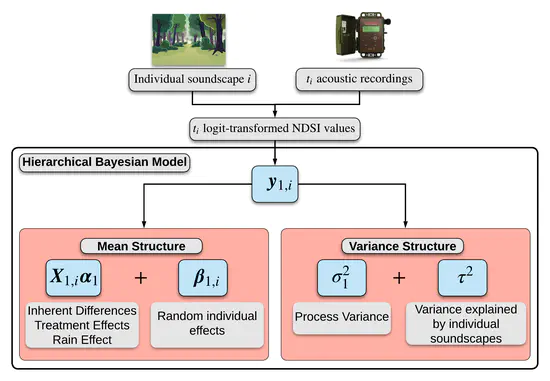Jeff Doser
Postdoctoral Research Associate
Michigan State University
Biography
I am a statistical ecologist interested in the development and application of hierarchical Bayesian models for wildlife and natural resource management and conservation. I currently work as a postdoctoral research associate in the Department of Integrative Biology at Michigan State University in the Zipkin Quantitative Ecology Lab. I received my PhD in Forestry and Ecology, Evolution, and Behavior at Michigan State University in the Geospatial Lab of Dr. Andrew Finley. My research interests lie in the development of Bayesian hierarchical models for environmental monitoring and decision making. More specifically, I am interested in the development and application of statistical models for methods of monitoring wildlife and plant populations across large spatio-temporal regions by leveraging a variety of data sources, including citizen science data and acoustic recordings.
- Statistical Ecology
- Wildlife Conservation
- Bayesian Modeling and Software
- Natural Resource Management
-
PhD Forestry and Ecology, Evolution, and Behavior, 2022
Michigan State University
-
MS Applied Statistics, 2021
Michigan State University
-
BS Mathematics and Biology, 2018
State University of New York at Geneseo
Skills
Experience
Courses taught:
- FOR/STT 875: R Programming for Data Sciences (Summer 2021-2022)
- IBIO 831: Statistical Methods in Ecology and Evolution (Spring 2022)
Courses taught:
- FOR 472: Ecological Monitoring and Data Analysis
- FOR/STT 875: R Programming for Data Sciences
Responsibilities included:
- Development of course textbook
- Hands on student assistance
- Teaching
Research Interests

Developing statistical models to understand biodiversity across macroscales
Understanding the drivers of species distributions and biodiversity at macroscales is complicated by a variety of ecological and observational complexities, such as spatial autocorrelation, nonstationarity in species-environment relationships, and species interactions. In my work, I account for these complexities to provide a more complete understanding of macroscale biodiversity and inform effective monitoring and conservation approaches across spatial scales.

Statistical ecology software development
Effective wildlife and natural resource management requires user-friendly software that makes state-of-the-art statistical tools accessible to natural resource managers and conservation practitioners. A key pillar of my research is developing computationally-efficient and accessible software to understand the ecological and anthropogenic drivers of species distributions, population dynamics, and biodiversity patterns.

Using autonomous monitoring systems to inform wildlife and natural resource management
Autonomous monitoring systems such as acoustic recording units, camera traps, and remote sensing methods (e.g., LiDAR) can provide massive amounts of data to inform biodiversity conservation, yet analyzing these data presents novel computational complexities. In my work, I develop quantitative approaches to leverage these complex data to inform a variety of wildlife and natural resource management objectives.